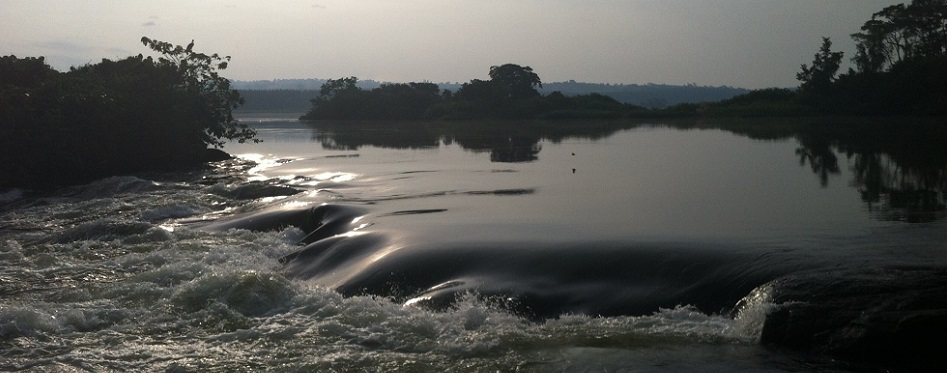
Save the Nile. Help us Save Adventure Tourism in Uganda

Access denied. If the Isimba Dam is constructed at its current proposed height, the rapids will be flooded and Uganda’s world class Grade 5 white water rafting will be consigned to history forever. Please help us get this decision changed! Photo Nile River Explorers.
The situation regarding the Isimba Hydro Power Project on the River Nile below Jinja has reached a critical stage!
In the next few weeks The World Bank, and Uganda’s National Environmental Management Authority (NEMA) will decide on the final size and scale of the Hydro Power Project. Will they authorize a smaller version of the dam? Or will they break an international agreement between the World Bank and the Government of Uganda to conserve this beautiful stretch of white water, and protect the booming adventure tourism industry and thousands of local jobs?
This decision is going on largely behind closed doors but we need to let the World Bank know that protecting the river and the Ugandan tourism industry is IMPORTANT TO YOU!
Background to the project
The Ministry of Energy and Mineral Development is planning to construct a hydro dam on the Nile at Isimba Falls, 50 km downstream from Jinja. The new dam will create a large reservoir of around 28 km² submerging the white water rapids on this section of the River Nile.
When the Bujagali Dam (hydroelectric power plant) was constructed, the World Bank and the Government of Uganda signed the Kalangala Offset Agreement. This binding agreement is supposed to protect specific, downstream sections of the River Nile free of construction of new dams and also protect the integrity of Mabira Forest.
According to Professor Wolfgang Thome, “any change of heart by the World Bank would amount to a fundamental breach of confidence and trust between the Bank and Uganda’s tourism fraternity.”
After the rapids at Bujagali were flooded, the rafting and kayaking companies moved activities downstream – below the dam – at significant expense. What will happen this time?
What impact will a new dam have?
This exceptional stretch of white water is famous worldwide. It is safe and warm; its consistent flows allow access to the river activities throughout the year, bringing tens of thousands of people to Uganda annually. A booming industry has been built around the white water and Jinja is regarded as the ‘adventure capital of East Africa.’ A large number of thriving businesses have grown around the central river adventure tourism activities: hotels, restaurants, taxi companies, boda boda drivers and shops.
An estimated 50,000 people take part in adventure activities every year around Jinja; many of whom would not travel to Uganda were it not for the amazing rapids.
If the Isimba Falls Project goes ahead in its current form, it will be a MASSIVE economic blow to Jinja. An independent study on the impact of the Isimba Hydro Project lists over 200 tourism related companies that will be affected. The vast majority are owned and run by Ugandans; collectively they employ thousands of Ugandans in long term, well-paid jobs.
Although “Isimba dam to create 3,000 jobs” – apparently – these are only temporary: constructing the dam.
Although different options for the size and scale of the Isimba dam were proposed, the decision has already been made to go with the largest scale option, the one that will destroy tourism.
The smaller dam option offers a balance of: much needed extra power for Uganda, while allowing adventure tourism to continue to flourish and expand, driving development forwards in the Jinja region.

You can also help by sharing this post and information – thank you! #conservation #Uganda #Nile #savetheNile#saveadventuretourisminUganda
Save the Nile. You can help!
Please email and/or write to your local World Bank representative, wherever you are in the world, and let them know that you are concerned about this issue!
You can find your local World Bank representative contact details here. [The Uganda World Bank contact is: Sheila Gashishiri, Communications Associate
+256-414-302-248 / 414-230-094 sgashishiri@worldbank.org ]
Please send them a letter and write them an email expressing your concerns. A template for the email/letter is below, which we suggest you modify to make it more personal:
Dear (ENTER REPRESENTATIVE’S NAME),
Representative for the World Bank in (ENTER YOUR HOME COUNTRY / REGION).
I am writing as a concerned citizen of (ENTER YOUR COUNTRY) about a serious issue in Uganda, which directly concerns The World Bank.
As a mitigation measure for the (World Bank backed) Bujagali Hydro Power Project, a conservation agreement called the Kalagala Offset Agreement was formed. The agreement between the World Bank and the Government of Uganda was put in place to protect the remaining stretch of rapids and river banks in the same region, for the sake of minimizing impact on the environment, the local people and eco tourism which flourishes in the area. Now, the Isimba Hydro Power Project will flood a significant portion of this conservation area – thus breaking this agreement.
Isimba HPP is funded by the Chinese government, and due to be constructed by a Chinese construction firm, both of whom seem unconcerned that a conservation area is due to be flooded. I am urging The World Bank to act on behalf of the thousands of Ugandans due to be negatively effected, as well as the environment, and the tourism that generates large amounts of income in an otherwise under developed region. Fifteen thousand people, including 12,000 Ugandans from the immediate area, have signed a petition demanding the agreement be upheld and a smaller version of the Isimba HPP to be constructed (which would leave the conservation area unaffected).
Please stand up to China and the Ugandan government and uphold the agreement that is laid out by The World Bank to protect the stretch of river due to be flooded.
Thank you for your support and understanding.
(ENTER NAME)
How else can I help #SavetheNile?
Like and share the ‘Save Adventure Tourism in Uganda’ Facebook page
Forward this message to anyone that can help raise awareness.
Please write to your World Bank representative TODAY about the Isimba Falls hydro power (dam) project – this is the most constructive way you can help.
You can also help by sharing this post and information – thank you!
Information courtesy of The Save Adventure Tourism in Uganda Team.
“Isimba Dam resurrects old environment-development debate,” wrote Solomon Oleny in the New Vision.



























I see construction has started, but which option? Does anyone know? Small, medium or large?
http://www.newvision.co.ug/news/658477-isimba-dam-construction-commences.html
And what will be the impact of this particular option on Jinja tourism and local communities?
Fantastic report and advice Charlotte – thank you very much.
So far the only option being considered is the highest one which although will generate a bit more power it is very debatable how worthwhile that will be as because of the size and cost of construction, this will make for very expensive hydro-power and is insignificant when matched to the returns from a big dam such as Karuma Falls one. AND this does not even take into consideration the cost to Uganda’s tourism offerings and potential for the future, the loss of a beautiful part of the River Nile for future generations and the thousands of people who will lose jobs / income / tax revenue / etc. while also breaching a covenant made with the World Bank when they funded the construction of the Bujagali Dam.
Save adventure tourism in Uganda shared a link on 8 October – “A fantastic new article published in the Daily Monitor highlighting the challenges the Jinja and Bujagali community faces with the proposed Isimba dam. Take note Ministry of Energy and Mineral Development – a compromise is possible!
Save adventure tourism in Uganda are NOT opposed to the Isimba dam entirely; we are promoting a scaling back of the dam to the smallest option that was originally proposed during feasibility studies.
The smaller option would still generate a great amount of power whilst maintaining the rapids for the tourism industry! A tourism industry that is Uganda’s top export earner and draws in US $1.4 billion (Shs3.7 trillion) annually!
You can still help by contacting your local World Bank representative today – details in the blog above. Thanks for supporting Uganda!
I contacted the World Bank representative in Uganda and got a standard acknowledgement letter.
Asking around town, my understanding is that the dam is definitely going ahead – the land is being cleared. However there is some kind of delay.
I’m still not sure which of the three proposed options is going ahead. If Uganda goes for the maximum ‘highest’ option, then its bye bye to rafting in Uganda and thousands of jobs… Rafting and related tourism industries understand the need to invest in power and have agreed that if the minimum option is built – meaning the river doesn’t rise to submerge the exposed rocks crucial for white water – there will still be enough new power generated to make the dam worth constructing + tourism (and 1000s of related jobs) are protected.
Let’s remember that the Ugandan government has noted that income generated by tourism is now the number one foreign exchange earner for the country. The percentage of GDP this influx of money represents is bound to increase even further over the next few years.
Another point that I find very interesting is that Uganda and Zimbabwe are the only two African countries that have grade 5 white water rafting. Expert rafters will travel the whole world looking for the right kind of white water. Zimbabwe has plans that will mean they will lose much (all?) of their grade 5 white water rafting. What does that mean? It means that would put Uganda in a league of its own: having the best grade 5 white water rafting in the whole of Africa. And we want to throw that away?
‘Isimba Dam to End Load Shedding in Uganda’ …. apparently…. a project update:
http://chimpreports.com/isimba-dam-to-end-load-shedding-in-uganda/
The dam has been constructed but Kampala residents still experience load shedding!
According to Kayak the Nile, “it is a common misconception that after completion of the Isimba Dam there will be no white water left on the Mighty White Nile.
While the Dam will sadly flood some of the rapids on this stretch of the river, there will still be plenty of white water, and Kayak the Nile, Nile SUP and the Nile River Festival will all adjust slightly and carry on.
There will be plenty of white water remaining!”
“Uganda Hydro Dams: New Tourism Reach”
Tony Ofungi writes:
“The Uganda Tourism Board (UTB) has made overtures with the energy sector in a bid to diversify Destination Uganda’s tourism products beyond the dominant wildlife-based tourism through the signing of a Memorandum of Understanding (MOU) with Uganda Electricity Generation Company Limited (UEGCL) to market the 600MW Karuma Hydro Power Dam and the 183MW Isimba Hydro Power Dams as infrastructure tourism products.”
How things have changed!
In 2007, the World Bank funded the Bujagali hydropower project, signalling “the disappearance of the first of the grade 5 rapids at Bujagali Falls,” a once-popular tourism spot that I visited many times during my first years in Uganda.
The Kalagala Offset (agreement between the International Development Association (World Bank) and the Ugandan Government) was designed to mitigate damages caused by the Bujagali Dam; it was also supposed to ensure the area (and its wildlife) would not be flooded by another hydro project. However, the construction of Isimba Dam below Bujagali Dam “trashed” that agreement, according to the author.
Uganda needs power but load shedding still exists, even after the latest dam has gone online.
Meanwhile, three quarters of the Nile once popular for white water rafting and kayaking has been submerged. Uganda’s white waters were legendary and still attract international visitors and competitors but let’s be honest, hydropower companies make an unlikely bedfellow for the tourism industry. The pandemic has fast-tracked the need to develop new products for domestic tourists.
Read the full article https://eturbonews.com/3002785/uganda-hydro-dams-new-tourism-reach/